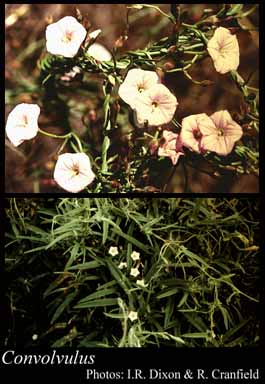- Reference
- Sp.Pl. 1:153 (1753)
- Name Status
- Current

Scientific Description
Family Convolvulaceae.
Habit and leaf form. Herbs, or herbaceous climbers, or shrubs; laticiferous, or non-laticiferous and without coloured juice. Autotrophic. Herbs annual, or perennial; plants with neither basal nor terminal concentrations of leaves. Climbing, or self supporting; stem twiners. Twining anticlockwise. Helophytic, mesophytic, and xerophytic. Leaves alternate; spiral; petiolate; non-sheathing; simple. Leaf blades dissected, or entire (entire to deeply lobed); pinnately veined, or palmately veined; cross-venulate; hastate, or sagittate. Leaves without stipules; without a persistent basal meristem. Stem anatomy. Nodes unilacunar. Secondary thickening anomalous, or developing from a conventional cambial ring; via concentric cambia, or from a single cambial ring.
Reproductive type, pollination. Fertile flowers hermaphrodite. Unisexual flowers absent. Plants hermaphrodite.
Inflorescence and flower features. Flowers solitary, or aggregated in ‘inflorescences’. Inflorescence few-flowered to many-flowered. Flowers in cymes, or in heads (heads dense). The terminal inflorescence unit cymose. Inflorescences terminal, or axillary; with involucral bracts (when inflorescence capitate), or without involucral bracts. Flowers bracteate; bi- bracteolate. Bracteoles minute to leaf-like. Flowers small to medium-sized; regular to somewhat irregular. The floral asymmetry (when noticeable) involving the perianth (K only). Flowers 5 merous; cyclic; tetracyclic. Free hypanthium absent. Hypogynous disk present; annular. Perianth with distinct calyx and corolla; 10; 2 -whorled; isomerous. Calyx 5; 1 -whorled; polysepalous; imbricate; regular to unequal but not bilabiate (equal or subequal); persistent; with the median member posterior. Corolla 5; 1 -whorled; gamopetalous; entire, or lobed; campanulate, or funnel-shaped; regular; hairy abaxially (on mid-petaline bands), or glabrous abaxially (rarely); white, or pink, or red to purple. Androecium 5. Androecial members adnate (to the corolla); all equal, or markedly unequal (usually); free of one another; 1 -whorled. Androecium exclusively of fertile stamens. Stamens 5. Staminal insertion near the base of the corolla tube. Stamens remaining included; oppositisepalous. Anthers dehiscing via longitudinal slits; introrse; tetrasporangiate. Pollen grains psilate. Gynoecium 2 carpelled. The pistil 2 celled. Gynoecium syncarpous; synstylovarious to eu-syncarpous (depending on interpretation of stigmatic area); superior. Ovary plurilocular; 2 locular. Gynoecium median. Styles 1; simple (filiform); apical. Stigmas 1, or 2 (depending on interpretation, the stigmatic area being more or less continuous (Lewis & Oliver (1965)); dry type; papillate; Group II type. Placentation basal. Ovules 2 per locule; ascending; apotropous; non-arillate; anatropous.
Fruit and seed features. Fruit non-fleshy; dehiscent; a capsule. Capsules loculicidal (via 4 valves), or splitting irregularly, or circumscissile (at the base). Fruit 1 locular, or 2 locular; 4 seeded. Seeds endospermic. Endosperm oily. Seeds conspicuously hairy, or not conspicuously hairy; winged, or wingless. Cotyledons 2. Embryo chlorophyllous; straight, or curved. Seedling. Germination phanerocotylar.
Physiology, biochemistry. Aluminium accumulation not found. Photosynthetic pathway: C3.
Geography, cytology, number of species. Native of Australia. Not endemic to Australia. Australian states and territories: Western Australia, South Australia, Northern Territory, Queensland, New South Wales, Victoria, Australian Capital Territory, and Tasmania. Eremaean Botanical Province and South-West Botanical Province.
Additional characters Pollen grains colpate. Stigmas the stigmatic area linear (oblong).
Taxonomic Literature
- Wheeler, Judy; Marchant, Neville; Lewington, Margaret; Graham, Lorraine 2002. Flora of the south west, Bunbury, Augusta, Denmark. Volume 2, dicotyledons. Australian Biological Resources Study.. Canberra..
- Johnson, R. W. 2001. A taxonomic revision of Convolvulus L. (Convolvulaceae) in Australia.
- Marchant, N. G.; Wheeler, J. R.; Rye, B. L.; Bennett, E. M.; Lander, N. S.; Macfarlane, T. D.; Western Australian Herbarium 1987. Flora of the Perth region. Part one. Western Australian Herbarium.. [Perth]..
- Jessop, J. P.; Toelken, H. R. 1986. Flora of South Australia. Part III, Polemoniaceae-Compositae. Govt. Print. Division.. Adelaide, S.A..
- Blackall, William E.; Grieve, Brian J. 1980. How to know Western Australian wildflowers : a key to the flora of the extratropical regions of Western Australia. Part IIIA. University of W.A. Press.. [Perth]..